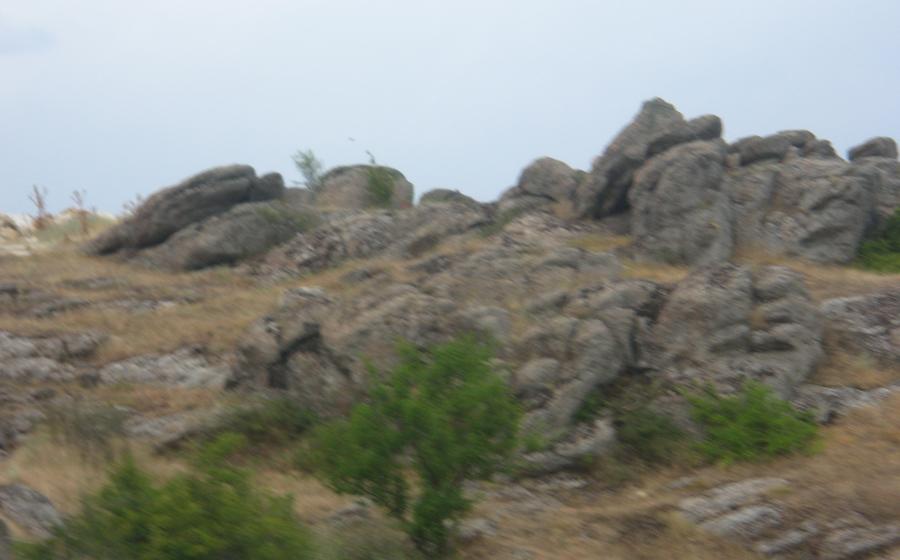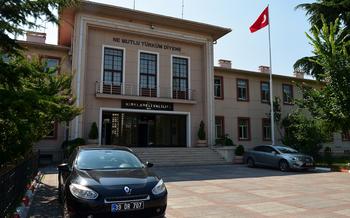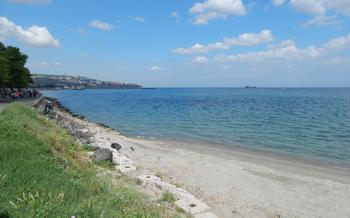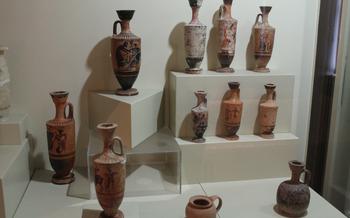
Vize Ancient Theater
- The Antiquity of Vize Ancient Theater
- Location and Accessibility
- Historical Background
- Architectural Features
- Acoustics and Performance
- Visiting the Theater
- Exploring the Surroundings
- Photography and Videography
- Educational Programs
- Insider Tip: Unveiling the Secret Cave
The Antiquity of Vize Ancient Theater
In the heart of the ancient city of Vize, nestled amidst rolling hills and lush forests, lies the Vize Ancient Theater, a testament to the region's rich cultural heritage. Built in the 2nd century AD, during the reign of the Roman Emperor Hadrian, the theater served as a vibrant center for entertainment and cultural expression.
The theater's impressive architecture showcases the engineering prowess of the ancient Romans. With its horseshoe-shaped auditorium and intricate stage design, the theater could accommodate thousands of spectators who gathered to witness theatrical performances, musical concerts, and religious ceremonies. Its well-preserved seating tiers, adorned with decorative friezes and inscriptions, offer a glimpse into the artistry and craftsmanship of the era.
Compared to other ancient theaters in the region, the Vize Ancient Theater stands out for its exceptional acoustics. The theater's design ensures that even the faintest whisper from the stage can be heard clearly in the farthest rows, creating an immersive and intimate atmosphere for performers and audience members alike.
One of the most intriguing aspects of the theater's history is the story of its discovery. In the early 20th century, a team of archaeologists led by Professor Ahmet Süleyman stumbled upon the ruins of the theater while conducting excavations in the area. As they carefully unearthed the ancient structure, they marveled at its remarkable preservation and the wealth of artifacts that shed light on the theater's past.
Location and Accessibility
The Vize Ancient Theater is located in the charming town of Vize, in the Kırklareli province of Turkey. Its exact address is Cumhuriyet Mahallesi, Atatürk Caddesi, Vize, Kırklareli, Turkey. To reach the theater, you can use the following GPS coordinates: 4827749, 242630
From Istanbul, the journey to Vize takes approximately 2 hours and 30 minutes by car, covering a distance of 186 kilometers. If you prefer public transportation, you can take a bus from Istanbul's Esenler Bus Station to Vize, which takes around 3 hours.
Once in Vize, the theater is conveniently situated within walking distance from the town center. You can easily find parking spaces near the theater, making it accessible for those traveling by car.
Historical Background
The ancient city of Vize, where the theater is located, dates back to the 7th century BC. It was founded by Greek colonists from Miletus and became an important city in the region. The theater was built in the 2nd century AD during the Roman period and was used for various performances, including plays, concerts, and religious ceremonies.
The theater played a significant role in the cultural and social life of Vize. It was a place where people gathered to be entertained, learn, and celebrate. Major events such as festivals, competitions, and political gatherings were held in the theater. It was also used for educational purposes, with philosophers and teachers giving lectures and conducting classes.
Several historical figures are associated with the theater. One of them is the Roman emperor Hadrian, who visited Vize in the 2nd century AD and is believed to have attended a performance in the theater. Another notable figure is the Byzantine emperor Justinian, who ordered the restoration of the theater in the 6th century AD.
Architectural Features
The Vize Ancient Theater exhibits remarkable architectural features that showcase the ingenuity and craftsmanship of its ancient builders. The seating arrangement, known as the cavea, comprises concentric tiers of stone seats, rising steeply from the orchestra. The proedria, reserved for distinguished guests, is located in the front rows, featuring wider and more elaborate seats.
The stage, or skene, is a rectangular platform located at the back of the orchestra. It consists of a raised stage for performances and a backdrop with niches and columns, providing a visually stunning setting for the actors and musicians. The orchestra, a circular space in front of the stage, served as a performance area for the chorus and musicians.
The theater's construction employed local limestone and marble. The meticulous craftsmanship is evident in the precisely cut and fitted blocks, creating a solid and durable structure. The use of vaulted arches and buttresses demonstrates the advanced engineering skills of the ancient builders, ensuring the theater's longevity.
The Vize Ancient Theater stands out for its well-preserved state compared to other theaters in the region. Its architectural features, including the seating arrangement, stage, and orchestra, closely resemble those of other ancient theaters in the Greco-Roman world, providing valuable insights into the architectural traditions of the period.
Acoustics and Performance
The Vize Ancient Theater is renowned for its exceptional acoustics, which have remained remarkably intact throughout the centuries. The theater's unique design, with its steeply raked seating and carefully positioned stage, creates an unparalleled sound experience. The natural reverberation of the theater allows the voices of performers to carry clearly and evenly throughout the auditorium, ensuring that every audience member can enjoy the show without any distortion or echoes.
In ancient times, the theater hosted a variety of performances, including plays, concerts, and religious ceremonies. The acoustics of the theater were particularly well-suited for dramatic performances, as the actors' voices could be heard clearly even from the back rows. The theater's unique acoustics also made it an ideal venue for musical performances, as the music could resonate throughout the space, creating a rich and immersive sound experience.
Anecdote:
A renowned actor, who had the privilege of performing in the Vize Ancient Theater, shared his unforgettable experience. He described how the theater's acoustics allowed him to connect with the audience on a deeper level. He could sense the emotions of the audience as their reactions and laughter reverberated throughout the theater. The actor felt a profound sense of connection with the ancient performers who had graced the same stage centuries before him.
Visiting the Theater
The Vize Ancient Theater is open to visitors all year round, with extended hours during the summer months. Admission fees are minimal, and guided tours are available for a more in-depth experience. These tours provide valuable insights into the theater's history, architecture, and significance, and are highly recommended for first-time visitors.
When planning your visit, consider the time of day and the season. The theater is most atmospheric in the late afternoon or evening, when the sun casts long shadows and creates a magical ambiance. During the summer months, it's best to visit early in the morning or late in the evening to avoid the midday heat.
A visit to the Vize Ancient Theater is a unique and rewarding experience that will transport you back in time to the days of ancient Greece and Rome. Whether you're a history buff, an architecture enthusiast, or simply someone who appreciates the beauty of ancient ruins, this theater is sure to leave a lasting impression.
Exploring the Surroundings
Beyond the theater itself, Vize offers a wealth of attractions and experiences for visitors to explore. Immerse yourself in the town's rich history by visiting the Vize Archaeological Museum, showcasing artifacts from the ancient city. For a taste of local culture, pay a visit to the Vize Bazaar, where you can find traditional Turkish handicrafts, souvenirs, and delicious street food.
Nature enthusiasts will delight in exploring the surrounding countryside. Embark on a scenic hike through the Vize Forest, home to diverse flora and fauna. Take a leisurely stroll along the banks of the Ergene River, where you can enjoy breathtaking views of the water and the surrounding landscapes.
Indulge in the local cuisine at one of the many restaurants in Vize. Savor the flavors of traditional dishes such as "Vize Köftesi" (local meatballs) or "Vize Pilavı" (rice pilaf with local spices). Pair your meal with a glass of refreshing "Vize Şarabı" (local wine), renowned for its unique taste.
For a truly authentic experience, venture off the beaten path and explore the surrounding villages. Immerse yourself in the local lifestyle, interact with friendly villagers, and discover hidden gems such as charming churches, mosques, and historical sites.
Photography and Videography
Amateur and professional photographers alike will find the Vize Ancient Theater a true feast for the eyes. The theater's weathered stone facade, intricate carvings, and sweeping vistas offer a wealth of opportunities to capture stunning photographs. For the best results, try to visit during the golden hours of sunrise or sunset, when the warm light casts a magical glow on the theater's ruins.
When it comes to videography, the theater provides a unique backdrop for creative storytelling. Whether you're filming a historical documentary, a travel vlog, or a short film, the theater's evocative atmosphere and rich history will add depth and intrigue to your project. Just remember to bring a sturdy tripod and plenty of batteries, as you'll likely want to spend hours capturing the theater's many angles and details.
If you're using a drone to capture aerial footage, be sure to check the local regulations and obtain any necessary permits before flying. The theater's location in a rural area provides plenty of open space for drone photography, but it's always best to be safe and respectful of any restrictions.
Educational Programs
The Vize Ancient Theater is not just a historical site; it also serves as an educational hub for students, researchers, and the local community. Various educational programs, workshops, and lectures are organized throughout the year to promote knowledge and appreciation of the theater's rich history and significance. These programs aim to engage participants in interactive learning experiences, fostering a deeper understanding of the theater's architecture, acoustics, performances, and cultural context.
Partnerships with local schools and universities ensure that students have access to the theater as a valuable educational resource. Field trips, guided tours, and hands-on activities allow students to explore the theater's ruins, learn about its construction techniques, and gain insights into the daily lives and entertainment of ancient civilizations.
One remarkable anecdote highlights the impact of these educational programs. A local teacher, Ms. Ayşe, shared her experience of using the theater as a teaching tool for her history class. By incorporating interactive sessions and role-playing activities within the theater's ancient walls, her students developed a deeper appreciation for the theater's historical significance and the vibrant culture of ancient Vize.
Insider Tip: Unveiling the Secret Cave
Just a short walk away from the Vize Ancient Theater lies a hidden gem that few visitors know about – a secret cave concealed amidst the surrounding hills. To find it, follow the path that leads from the theater's exit and keep an eye out for a small, unassuming entrance tucked between the rocks.
The cave is a natural wonder, with stalactites and stalagmites of all shapes and sizes adorning its walls and ceiling. As you enter, you'll be greeted by a cool breeze and the sound of dripping water. The cave extends deep into the hillside, with several chambers to explore.
For an unforgettable experience, bring a flashlight and venture into the darker corners of the cave. You might just discover hidden passages and formations that few have seen before. And if you're lucky, you might even spot some of the local wildlife, such as bats or small reptiles, that call this cave their home.
This secret cave is the perfect place to escape the crowds and immerse yourself in the natural beauty of Vize. So, after exploring the ancient theater, be sure to seek out this hidden gem for a truly unique and memorable experience.









